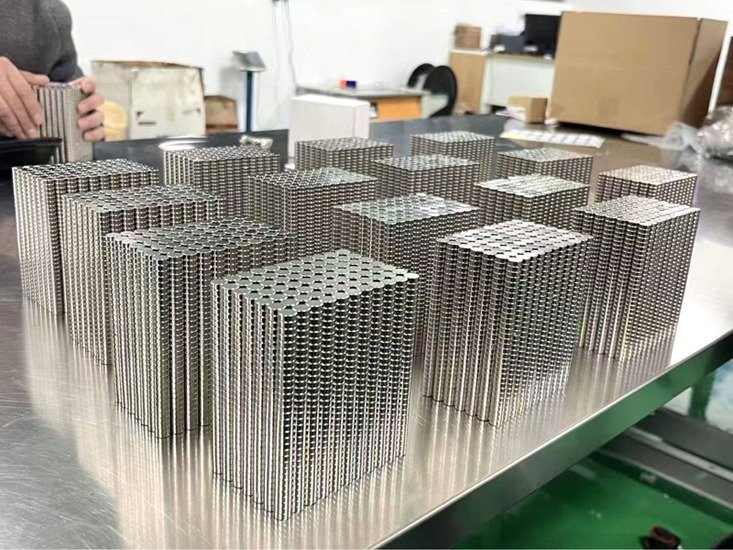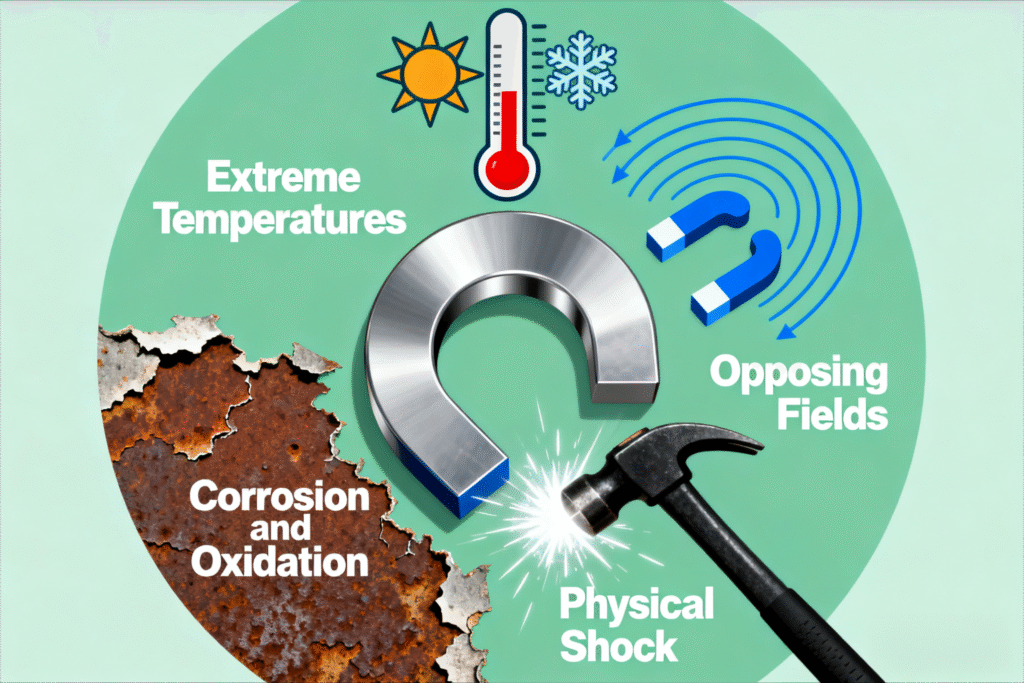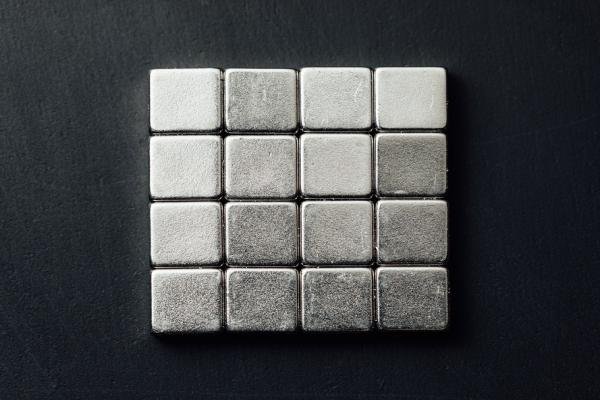So, why are neodymium magnets so strong? They’re incredibly powerful because of their unique atomic makeup. These magnets contain a special blend of three elements: Neodymium, Iron, and Boron (Nd₂Fe₁₄B). This combination creates something called exceptionally high magnetic anisotropy.
This special property comes from the tetragonal crystal shape of the material. It means the magnet really wants to be magnetized in just one direction. That’s it.
When manufacturers combine this natural tendency with a process that lines up all the tiny magnetic regions inside the material, something amazing happens. The result is an intensely focused and powerful external magnetic field. This is the science behind strong magnets and what makes neodymium magnets the strongest type of magnet you can buy.
Table of Contents
Atomic and Crystalline Secrets
To truly understand how powerful these magnets are, we need to look at the basic science. The strength isn’t magic. It comes from specific material properties and careful engineering at the atomic level.
This blend of chemistry and physics creates magnetic performance that has changed countless industries forever.
The Magic Trio: Nd₂Fe₁₄B
The power starts with the neodymium magnet composition, a specific metallic compound discovered in the 1980s. Each element has a critical job that can’t be replaced.
Iron (Fe) does the heavy lifting. As a ferromagnetic material, it provides the basic high magnetic moment. Think of it as the raw potential for strong magnetism.
Neodymium (Nd) is a rare-earth element and the key player. It provides extremely high magnetic anisotropy. This is the secret to locking that magnetic potential in a single direction.
Boron (B) acts like glue. It helps “stick” the neodymium and iron atoms together into the exact crystal structure needed for these amazing properties to work.
Tetragonal Crystalline Anisotropy
Magnetic anisotropy is a material’s preference for being magnetized in one specific direction. Scientists call this an “easy axis.” The Nd₂Fe₁₄B compound forms a tetragonal crystal structure.
This specific crystal shape has very high uniaxial anisotropy. This means it takes much less energy for the magnet to be magnetized along one specific direction. It takes enormous energy to magnetize it any other way.
Think of it like splitting wood. It’s far easier to split a log along its grain than to chop through it across the grain. The crystal has a “magnetic grain.” Its anisotropy makes sure all the magnetic force flows along that grain. For a deeper dive into this concept, resources like Georgia State University’s HyperPhysics offer excellent explanations.
Aligning the Magnetic Domains
Inside the magnet material, there are tiny regions called magnetic domains. In these domains, the magnetic moments of all the atoms already point in the same direction.
In an unmagnetized piece of neodymium alloy, these many domains point in random directions. Their individual magnetic fields cancel each other out. The result is no net external magnetic field.
The manufacturing process exposes the material to an incredibly powerful external magnetic field. This forces all the individual magnetic domains to snap into alignment. They all point along the crystal’s “easy axis.” It’s like turning a chaotic crowd into a disciplined army, with every soldier facing the same direction.
High Remanence and Coercivity
This perfect alignment creates two critical properties that define the neodymium magnet strength explained in technical terms: remanence and coercivity.
Remanence (Br) is the strength of the magnetic field that the magnet keeps after the external magnetizing field is removed. Because all the domains in a neodymium magnet are locked in alignment, it keeps an exceptionally high level of magnetism. This gives it powerful pull.
Coercivity (Hci) is the material’s ability to resist being demagnetized by an opposing external magnetic field or by heat. Thanks to its high anisotropy, it’s very difficult to knock the domains out of alignment. This makes the magnet’s strength durable and reliable.
It’s this powerful combination of very high remanence (a strong field) and very high coercivity (a stable field) that makes neodymium magnets so incredibly powerful and useful in real life.
From Powder to Power
The natural properties of the Nd₂Fe₁₄B alloy are only potential. Unlocking that potential requires a sophisticated and precise manufacturing process. This journey from raw alloy to finished, powerful magnet explains how neodymium magnets are made so strong.
Each step is designed to preserve and boost the magnetic properties defined at the atomic level.
Step 1: Creating the Alloy
The process begins in a vacuum induction furnace. Raw, high-purity neodymium, iron, and boron are melted together in a vacuum or inert gas environment.
This prevents the highly reactive neodymium from oxidizing. It ensures the precise Nd₂Fe₁₄B chemical composition is achieved. The molten alloy is then cooled into solid blocks.
Step 2: Jet Milling into Powder
The solid alloy blocks are brittle and are crushed and then jet milled. This process uses a high-speed stream of inert gas to smash the material against itself. This breaks it down into a fine powder.
The particles are typically only a few micrometers in size. Crucially, each tiny grain of this powder is a single perfect crystal with its own “easy axis” of magnetization.
Step 3: Pressing in a Magnetic Field
This is the most critical step for achieving high strength. The fine powder is poured into a die cavity shaped like the final magnet.
While in the die, the powder faces two forces at the same time. First, a massive external magnetic field is applied. This physically rotates every single powder grain to align its “easy axis” in the same direction.
Second, immense mechanical pressure is applied to compact the powder. This locks the perfectly aligned particles into a dense, solid block. This is where the “disciplined army” of magnetic domains forms on a large scale.
Step 4: Sintering and Annealing
The compacted block, known as a “green” compact, is still fragile. It’s then placed in a sintering furnace.
The block is heated to a temperature just below the alloy’s melting point (over 1000°C). At this temperature, the particles fuse together. They form a solid, dense object that’s about 75% of its original size. The process is carefully controlled to maintain the magnetic alignment achieved during pressing.
After sintering, a multi-stage annealing (controlled cooling) process optimizes the microstructure of the grain boundaries. This enhances both remanence and coercivity.
Step 5: Machining, Coating, and Magnetization
The sintered material is extremely hard and brittle, similar to ceramic. It can’t be machined with regular tools. Diamond-coated grinding wheels are used to machine the magnet to its final precise dimensions.
Because the iron in the alloy rusts and neodymium is reactive, a protective coating is essential. A triple-layer coating of Nickel-Copper-Nickel (Ni-Cu-Ni) is most common. It provides excellent corrosion resistance.
Finally, the finished, coated magnet is placed inside a large solenoid coil. An enormous pulse of electricity is sent through the coil. This creates a magnetic field powerful enough to magnetize the material to its full potential, or saturation. The magnet is now fully “charged” and ready for use.
A League of Their Own
To understand the real impact of neodymium magnets, it helps to compare them to other common magnet types. This context shows why they’re the preferred choice for high-performance applications.
The differences in strength, cost, and temperature resistance are significant. They dictate how these magnets are used.
Neodymium vs. Ferrite Magnets

Ferrite magnets, also known as ceramic magnets, are the common, low-cost “black magnets” found in refrigerator decorations and basic craft projects. While useful, their performance is dwarfed by neodymium.
A direct comparison of what makes neodymium magnets strong reveals the stark differences.
Feature | Neodymium Magnets | Ferrite (Ceramic) Magnets |
Magnetic Strength (BH)max | Very High (up to 52 MGOe) | Low (~3.5 MGOe) |
Coercivity | Very High | Moderate |
Cost | Higher | Very Low |
Temperature Resistance | Moderate (improves with grades) | Excellent |
Corrosion Resistance | Poor (requires coating) | Excellent (it’s an oxide) |
Brittleness | Very Brittle | Brittle |
The key takeaway is strength. A neodymium magnet can be over 10 times stronger than a ferrite magnet of the same size. This allows for extreme miniaturization and power. It makes devices like modern headphones, smartphones, and drones possible. For official material standards, you can refer to resources like the Magnet Materials Producers Association (MMPA).
Neodymium vs. Samarium Cobalt
Samarium Cobalt (SmCo) is another type of rare-earth magnet. It’s the closest competitor to neodymium in terms of performance.
The primary trade-off is between strength and temperature resistance. Neodymium magnets are generally stronger at room temperature. However, SmCo magnets perform much better at high temperatures and have superior corrosion resistance without needing a coating.
This makes SmCo the magnet of choice for demanding applications in aerospace, military, and high-temperature industrial motors. Standard neodymium grades would fail in these environments due to heat-induced demagnetization.
A Practical Guide to Choosing

Selecting the right strong neodymium magnet involves more than just picking the biggest one. Understanding the technical specifications is key to matching the magnet to your application for optimal performance and longevity.
This is where technical knowledge translates into practical success. Whether for an engineering project, a commercial product, or a sophisticated DIY build.
Decoding Neodymium Magnet Grades
Neodymium magnets are identified by a grade. This is typically a number preceded by an “N,” such as N35, N42, or N52.
This “N-number” represents the Maximum Energy Product of the magnet. It’s a figure that indicates its stored magnetic energy. This value is measured in MegaGauss-Oersteds (MGOe).
The rule is simple: a higher number means a stronger magnet. An N52 grade magnet is significantly stronger than an N35 of the exact same size. N52 is currently one of the strongest grades widely available for commercial use. When choosing strong neodymium magnets, the grade is the first and most important indicator of its power.
For a comprehensive overview of the different grades, shapes, and sizes available, you can explore our full range of neodymium magnets.
The Critical Temperature Factor
While the N-number indicates strength, letters following the grade indicate the magnet’s maximum operating temperature. This is a crucial specification. Exceeding this temperature will cause the magnet to permanently lose strength.
The standard temperature ratings are:
- No letter (e.g., N42): ~80°C (176°F)
- M (e.g., N42M): ~100°C (212°F)
- H (e.g., N42H): ~120°C (248°F)
- SH (e.g., N42SH): ~150°C (302°F)
- UH (e.g., N42UH): ~180°C (356°F)
- EH (e.g., N38EH): ~200°C (392°F)
- AH (e.g., N35AH): ~220°C (428°F)
Choosing an ‘SH’ or ‘UH’ grade is essential for applications that generate heat. This includes high-performance electric motors or sensors operating in harsh environments.
The Application Matrix
Matching the right grade and temperature rating to the task is key. This matrix provides guidance for common applications.
Application | Recommended Grade(s) | Key Considerations |
High-Performance Motors (Drones, EVs) | N45SH, N48UH, N50M | High strength for torque and high-temperature resistance for continuous operation are critical. |
Audio (Speakers, Headphones) | N48, N50, N52 | Maximum magnetic flux density is needed for the best acoustic performance and efficiency. |
Sensors and Actuators | N35, N42, N45 | Field consistency and specific magnetic pole configuration are often more important than maximum strength. |
Holding & Clamping (Fixtures, DIY) | N35, N42, N45 | A good balance of high pull force and cost-effectiveness. The N-grade directly impacts holding power. |
Consumer Electronics & Closures | N38M, N42 | Miniaturization demands high strength in a small package. Reliable, consistent force is key for closures. |
High-Temperature Industrial Use | N35EH, N38AH | Must withstand harsh operating environments without demagnetizing over time. |
To see how these grades are implemented across various industries, from renewable energy to medical devices, visit our applications page.
Handling the Power Safely

The immense strength of neodymium magnets also brings significant safety challenges. Understanding their physical properties and handling them with respect is essential to prevent injury and damage.
These are not toys. Their power demands careful and informed handling.
The Brittleness Paradox
A common surprise for new users is how easily these powerful magnets can break. The sintered metal alloy that gives them their magnetic strength is structurally more like ceramic than steel. It’s extremely hard but has very low ductility, meaning it’s brittle.
We’ve seen countless cases where two magnets are allowed to snap together from a distance. The force of their attraction accelerates them to high speeds. Upon impact, the kinetic energy has nowhere to go and can instantly shatter one or both magnets. This sends sharp, magnetic shards flying.
Always slide magnets apart rather than trying to pull them directly. Never allow them to collide.
The Threat of Demagnetization
Can neodymium magnets lose their strength? Yes, but not under normal conditions. A neodymium magnet will retain its strength for decades if kept within its operational limits.
The primary causes of permanent demagnetization are:
- Heat: Exceeding the maximum operating temperature specified by its grade (e.g., 80°C for a standard N-grade).
- Opposing Magnetic Fields: Exposure to very strong external magnetic fields from other powerful magnets or large electromagnets can begin to reverse the alignment of the magnetic domains.
- Physical Shock: While minor, severe and repeated impacts can slowly contribute to misaligning domains over time.
- Radiation: In highly specific nuclear or scientific applications, radiation can disrupt the crystal structure and degrade magnetic properties.
A Critical Safety Guide
Safe handling of strong magnets is non-negotiable. Always follow these critical warnings.
- Pinching Hazard: Large neodymium magnets can attract each other with enough force to crush fingers and break bones. Always wear safety gloves and eye protection when handling them.
- Pacemakers & Medical Devices: Keep magnets at a safe distance—at least 12 inches (30 cm)—from anyone with a pacemaker, ICD, or other implanted medical device. The strong field can interfere with or disable these life-sustaining devices.
- Electronic Damage: These magnets can permanently damage magnetic media like credit cards and computer hard drives. They can also damage smartphones, tablets, and older CRT monitors. Keep them away from all sensitive electronics.
- Choking Hazard: Small magnets are a serious and potentially fatal danger if swallowed. If multiple magnets are swallowed, they can attract each other through intestinal walls. This leads to catastrophic internal injuries. Keep all neodymium magnets away from children.
- Shattering Risk: As noted, they’re brittle. Always wear safety glasses when handling them. A collision can cause them to shatter and project sharp fragments.
For more information, government bodies like the U.S. Consumer Product Safety Commission (CPSC) provide public warnings on magnet safety.
The Future is Magnetic
The science of neodymium magnets continues to evolve. It’s pushing the boundaries of what’s possible in technology, energy, and engineering. Understanding these materials is key to harnessing their future potential.
From green energy to advanced computing, the quest for stronger, more efficient magnetic materials is relentless.
Beyond the N52 Grade
Research is constantly underway to improve magnetic materials. Efforts focus on creating even stronger magnets and improving high-temperature performance through techniques like grain boundary diffusion. Scientists are also finding ways to reduce reliance on expensive and supply-constrained rare-earth elements like neodymium and dysprosium.
Breakthroughs in this field, often covered in journals like Nature, promise to enable even more efficient electric motors and power generators. As described in engineering publications, this is critical for the future of electric vehicles and renewable energy.
Your Project, Our Expertise
Choosing and implementing the right magnetic solution is a complex technical decision. It impacts performance, cost, and reliability. The science behind strong magnets is intricate. Navigating the world of grades, coatings, and magnetization patterns requires experience.
A knowledgeable partner can help you avoid common pitfalls and optimize your design for success.
At CNM MAGNET, we’re committed to providing the highest quality magnetic materials backed by deep technical expertise. We help engineers, innovators, and businesses turn ambitious ideas into reality. Learn more about us and discover how our experience can power your next project.
A Summary of Strength
The incredible power of neodymium magnets isn’t a single feature. It’s a convergence of three critical factors.
First is the unique atomic recipe of Nd₂Fe₁₄B. This creates a crystal structure with immense intrinsic magnetic anisotropy.
Second is the advanced manufacturing process that aligns these crystals and their magnetic domains into a single, unified direction.
Finally, this perfect alignment results in extremely high remanence and coercivity. This creates a powerful and stable magnetic field that has reshaped modern technology. From tiny headphones to massive wind turbines, these remarkable materials are a quiet force driving our world forward.
We are a manufacturer specializing in the research and development of magnets with years of industry experience. Our product offerings include NdFeB magnets, ferrite magnets, and custom magnetic components. Our goal is to provide high-quality magnetic solutions to customers worldwide, and we also offer OEM/ODM customization services. If you have any questions about magnets or custom applications, please feel free to contact our team of experts.
Facebook
Twitter
LinkedIn
WhatsApp

